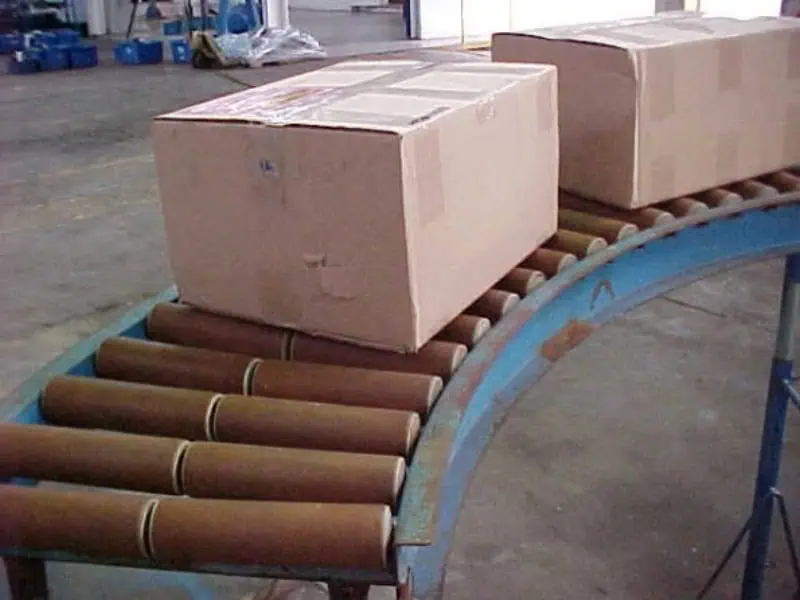They’re a smart option when workload spikes, space is tight, and fast setup is needed without capital spend for material handling roller conveyors. The choice depends on product mix, floor conditions, and the time window you’re working within. In many projects, Conveying & Hoisting Solutions’ material handling roller conveyors make light work of shifting loads efficiently while staying flexible for short-term demands. This article outlines the benefits, limitations, specifications, and when to upgrade to more powerful systems, allowing you to give the idea a fair try.
What makes material handling roller conveyors ideal for temporary setups?
They suit temporary setups because they arrive in modular sections, assemble quickly, and run without power, so you can get cracking the same day. In short, they slot into odd spaces and keep things moving without drama. Here are the setup advantages:
- Modularity: Sections connect fast, scale up or down, and curve where aisles dogleg.
- No power needed: Gravity, slope, or a light push drives flow—handy on sites with limited power drops.
- Adjustable stands: Standard stands cover roughly 540–840 mm heights, which helps on uneven slabs and mezzanines.
- Guarding options, such as rails, end stops, and toe boards, reduce knock-ons and pinches during peak chaos.
- Compact storage: When the rush is over, sections are palletised and tucked away.
- Simple familiarisation: Crews adapt quickly, so the line’s earning its keep before smoko.
Since short-term work is time-sensitive, you’ll prioritise low upfront costs and minimal training requirements. When volumes hop around bay to bay, a quick re-layout keeps you on the front foot. A tidy setup also reduces double-handling—less hard yakka for the team. In short, for pop-up or seasonal tasks, roller lines are the practical option.
How do gravity roller conveyors simplify short-term warehouse operations?
They simplify operations by de-cluttering forklift traffic and creating a predictable path for cartons, which stabilises receiving, kitting, and dispatch during peaks. In a bump-in, fewer moving parts mean fewer headaches. Here are the operational wins:
- Faster bump-in/out: Sections are light enough for two people, allowing changes to occur before the next truck arrives.
- Safer traffic patterns: Fixed roller paths cut risky crossovers with pallet movers.
- Quiet running: No motors means less noise—gold when you’re flat out indoors.
- Easy merges and gates: Install a spur or swing gate to maintain open access at workstations.
- Reduced handling: Items roll instead of being carried, which lowers strain and speeds packing.
For a ready-to-go kit and a transparent spec sheet, trusted solutions for material handling roller conveyors provide a solid baseline for hire planning that aligns with common carton sizes and floor setups.
Gravity roller hire quick specs (for planning)
| Item | Dimension 1 | Dimension 2 | Notes |
| Straight section | Length 3000 mm | Roller width 385 mm | Overall width 455 mm |
| 90° bend section | Length 1700 mm | Roller width 385 mm | Overall width 455 mm |
| Rollers & frame | Ø 50 mm | Pitch 75 mm | Frame height 100 mm |
When cartons vary widely, watch for limited throughput on mixed weights; you may need to tweak pitch, swap roller surface, or add short powered assists. The upside is fast redeployment, allowing lines to follow work as priorities shift between inbound and dispatch.
Why should you consider roller conveyors for flexible hire applications?
Consider them when job scopes change weekly and you need equipment that can grow, split, or move between bays without stopping the show. The gear is built to be rejigged as tasks evolve.
Here are the flexibility benefits:
- Scale in steps: Begin with a single straight run, then add curves or a spur as your SKUs increase.
- Mix frame duties: Use light/medium sections where they fit best rather than over-engineering everything.
- Reusable inventory: Relocate sections across sites or projects—handy when timelines slip.
- Low noise: Keeps morale up during long shifts and makes toolbox talks easier to hear.
- Quick storage: When a campaign wraps, stack and stow without chewing up floor space.
Across events, pop-up DCs, and maintenance shutdowns, flexible hire lets you chase demand without locking in fixed assets. That’s particularly useful when long-term volumes are still on the cards but not a sure thing.
When is a heavy-duty conveyor better suited for long-term projects?
A heavy-duty or powered system fits when loads are dense, packaging is sticky, slopes are unavoidable, or the route is long with multiple workstations. If the line is permanent, the control and accumulation features often repay the capex. Here are the long-haul triggers:
- Mixed heavy weights: Powered rollers maintain consistent velocity across varied SKUs.
- Long routes: Zoned accumulation reduces back-pressure at pack benches.
- Slopes and merges: Integrated controls hold and gap cartons where needed.
- Automation roadmap: Future scanners, diverters, or stops plug in cleanly.
Gravity is less suited to steep inclines, especially with clingy packaging or high-friction bases. In those awkward spots, a hybrid works well—keep gravity for the straight, level stretches and drop powered modules where control matters most. That way, you get reliability without overbuilding the entire line.
Can material handling roller conveyors improve job site efficiency?
Yes—job sites benefit when predictable flows replace ad-hoc carries and trolleys. By setting fixed paths, trades coordinate better, forklifts travel less, and queues shrink.
Here are the on-site efficiency gains:
- Safer carries: Rolling cartons reduce lift counts and strain for crews.
- Clearer access: Lift gates and transfer plates maintain walk-throughs at work areas.
- Faster hand-offs: Defined infeed zones keep hoists and crane drops tidy.
- Routine checks: Simple inspection points make hazard control a daily habit.
- Training prompts: Quick toolbox refreshers keep methods sharp in changing conditions.
To reinforce those habits, supervisors often rely on maintenance training for mechanical equipment, which strengthens inspection, commissioning, and safe operating practices for conveyor components. That level of discipline reduces potential downtime risk and helps jobs finish on schedule rather than running overtime.
Which industries benefit most from short-term conveyor hire?
Any sector that swings between calm and full tilt will see gains from temporary roller lines. If you need to move boxed, flat-bottomed material quickly, they’re worth a burl. Here are the high-impact sectors:
- Retail and e-commerce: Peak dispatch lanes, returns triage, and kitting during promos.
- Construction and fitout: Feeding joinery, fixtures, or hardware to trades across levels.
- Light manufacturing involves assembling cells during changeovers or pilot runs.
- Events and exhibitions: Quiet, modular flow for bump-ins and pack-downs.
- Agriculture: Seasonal packing sheds where cartons are consistent and flat-bottomed.
When demand steadies for months, consider placing select powered sections in the toughest zones—this gives gravity the easy bits and keeps energy bills down. That hybrid approach keeps the crew moving without blowing the budget.
Choosing the right material handling roller conveyors for your project duration
Choosing the right conveyor hinges on task, terrain, and time. Start by matching carton mix and friction to roller type, setting pitch and guarding early, and reviewing throughput weekly so adjustments happen before issues snowball. For temporary, changing work, go gravity first and add curves or spurs as patterns emerge; for permanent, precise flows, use powered where velocity control and gapping are crucial; for mixed friction or unavoidable slopes, blend powered modules only on the problem segments; and for safety and uptime, build in stands, end stops, and inspection routines from day one. For guidance aligned to site conditions and deadlines, explore how Conveying & Hoisting Solutions delivers reliable handling systems to pressure-test hire duration against configuration and keep the crew moving without dramas.




